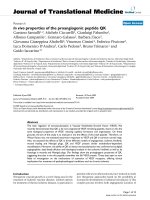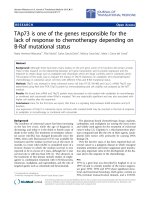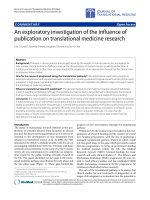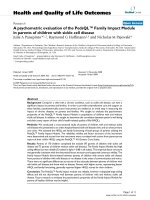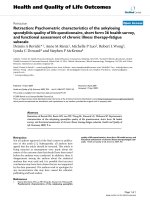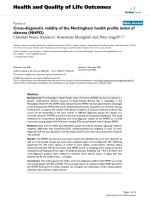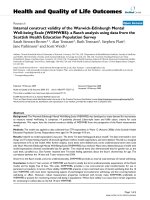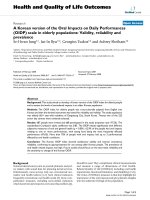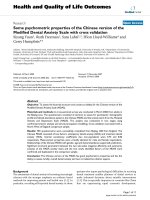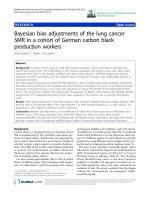Báo cáo hóa học: " Non coding extremities of the seven influenza virus type C vRNA segments: effect on transcription and replication by the type C and type A polymerase complexes" ppt
Bạn đang xem bản rút gọn của tài liệu. Xem và tải ngay bản đầy đủ của tài liệu tại đây (324.62 KB, 11 trang )
BioMed Central
Page 1 of 11
(page number not for citation purposes)
Virology Journal
Open Access
Research
Non coding extremities of the seven influenza virus type C vRNA
segments: effect on transcription and replication by the type C and
type A polymerase complexes
Bernadette Crescenzo-Chaigne
1
, Cyril Barbezange
1,2
and Sylvie van der
Werf*
1
Address:
1
Unité de Génétique Moléculaire des Virus Respiratoires, URA 3015 CNRS, EA 302 Université Paris Diderot, Institut Pasteur, F-75724
Paris, France and
2
UMR 1161 Virologie Afssa Inra Enva, 23 avenue du Général de Gaulle, 94706 Maisons-Alfort cedex, France
Email: Bernadette Crescenzo-Chaigne - ; Cyril Barbezange - ; Sylvie van der Werf* -
* Corresponding author
Abstract
Background: The transcription/replication of the influenza viruses implicate the terminal
nucleotide sequences of viral RNA, which comprise sequences at the extremities conserved among
the genomic segments as well as variable 3' and 5' non-coding (NC) regions. The plasmid-based
system for the in vivo reconstitution of functional ribonucleoproteins, upon expression of viral-like
RNAs together with the nucleoprotein and polymerase proteins has been widely used to analyze
transcription/replication of influenza viruses. It was thus shown that the type A polymerase could
transcribe and replicate type A, B, or C vRNA templates whereas neither type B nor type C
polymerases were able to transcribe and replicate type A templates efficiently. Here we studied
the importance of the NC regions from the seven segments of type C influenza virus for efficient
transcription/replication by the type A and C polymerases.
Results: The NC sequences of the seven genomic segments of the type C influenza virus C/
Johannesburg/1/66 strain were found to be more variable in length than those of the type A and B
viruses. The levels of transcription/replication of viral-like vRNAs harboring the NC sequences of
the respective type C virus segments flanking the CAT reporter gene were comparable in the
presence of either type C or type A polymerase complexes except for the NS and PB2-like vRNAs.
For the NS-like vRNA, the transcription/replication level was higher after introduction of a U
residue at position 6 in the 5' NC region as for all other segments. For the PB2-like vRNA the CAT
expression level was particularly reduced with the type C polymerase. Analysis of mutants of the
5' NC sequence in the PB2-like vRNA, the shortest 5' NC sequence among the seven segments,
showed that additional sequences within the PB2 ORF were essential for the efficiency of
transcription but not replication by the type C polymerase complex.
Conclusion: In the context of a PB2-like reporter vRNA template, the sequence upstream the
polyU stretch plays a role in the transcription/replication process by the type C polymerase
complex.
Published: 30 October 2008
Virology Journal 2008, 5:132 doi:10.1186/1743-422X-5-132
Received: 23 March 2008
Accepted: 30 October 2008
This article is available from: />© 2008 Crescenzo-Chaigne et al; licensee BioMed Central Ltd.
This is an Open Access article distributed under the terms of the Creative Commons Attribution License ( />),
which permits unrestricted use, distribution, and reproduction in any medium, provided the original work is properly cited.
Virology Journal 2008, 5:132 />Page 2 of 11
(page number not for citation purposes)
Background
Type A, B and C Influenza viruses are members of the
Orthomyxoviridae family. Their genome is segmented and
consists of eight segments for type A and B influenza
viruses and only seven segments for type C influenza virus
that has only one envelope glycoprotein instead of two for
the type A and B viruses. Each genomic segment forms a
ribonucleoprotein complex (vRNP), composed of a sin-
gle-stranded RNA molecule of negative polarity (vRNA)
associated with molecules of nucleoprotein (NP) and the
polymerase complex (P) formed of the PB1, PB2 and PA/
P3 proteins.
For each genomic viral RNA, the coding region is flanked
by non-coding (NC) sequences at both ends of the seg-
ment. These terminal nucleotide sequences are involved
in the transcription and replication of viral RNA [1,2]
which further require the P and NP proteins. In the
nucleus of infected cells, three different RNAs of viral ori-
gin are synthesized for each segment. The messenger
RNAs (mRNAs) are products of the transcription process.
They are capped at the 5' end with a 10 to 13 nucleotides
(nt) sequence of nonviral origin derived from newly syn-
thesized host nuclear RNAs through a so-called cap-
snatching mechanism. At their 3' end they possess a
poly(A) sequence that results from termination of RNA
synthesis at a polyU sequence localized 17 to 22 nt
upstream of the 5' end of the genomic vRNA template.
The full length complementary RNAs of positive polarity
(cRNAs) are a product of the replication process and serve
as template for the synthesis of genomic vRNAs. Initiation
of the synthesis of cRNAs and vRNAs is primer-independ-
ent and anti-termination occurs at the polyU sequence
during cRNA synthesis (for review [3]).
The NC sequences can be divided into two parts: the con-
served and the non conserved sequences [1]. The length of
the conserved NC sequences varies between virus types. At
the 3' end, the conserved sequence is 12 nt long for type A
and B influenza viruses and 11 nt long for type C viruses.
At the 5' end, the conserved sequence is 13, 11 and 12 nt
long for type A, B and C viruses, respectively [4-6]. The
role of the conserved NC sequences has been extensively
studied. In cell culture experiments, it was shown that the
conserved 3' and 5' NC sequences are sufficient for the
expression, the replication and the packaging of the
genomic segments [7]. In vitro studies suggested that the
promoter for transcription is entirely contained within the
3' and 5' NC sequences [8,9], and it was recognized that
an interaction between the 3' and 5' NC sequences is
required for transcription initiation [10]. Indeed, these
conserved NC sequences are partially complementary to
each other and have the ability to form partially double-
stranded structures involved in the transcription and the
replication, in the shape of a panhandle [11-13], or a dou-
ble hairpin loop or so-called corkscrew structure [14-17].
The role of the polymerase complex in the replication and
transcription processes has been mainly studied for type A
influenza viruses. The precise domains of interaction
between the three polymerase proteins have been defined
[18] and their respective role in the transcription and rep-
lication processes was analyzed [19]. Type A, B and C
influenza viruses share common sequences in the con-
served 3' and 5' NC regions of the viral RNA segments.
Within each type of influenza viruses and each sub-type of
type A influenza viruses, the non conserved NC sequences
differ in length and nucleotide composition for the differ-
ent segments [4,5]. In the case of type A influenza virus,
the non conserved NC sequences were shown to modu-
late the efficiency of transcription and replication [1,2].
We previously showed that type B virus vRNAs could serve
as templates for transcription and replication by type A, B
and C polymerase complexes [20]. Furthermore, Weber et
al. [21] showed that type B but not type A vRNA templates
could be used to some extent by the Thogotovirus
polymerase complex, another member of the Orthomyxo-
viridae family. However, neither type C vRNA templates,
nor type C polymerase complex proteins, were included
in their study. We also showed, using only incomplete NC
region sequences of the NS segment, that the polymerase
complex of type A influenza virus was able to transcribe
and replicate vRNA templates from type A, B and C viruses
[20]. In contrast, transcription and replication of the
reporter vRNA template with type A extremities in the
presence of the type C polymerase complex was reduced
[20]. Differences in the conserved 3' and 5' NC regions
between type A and C vRNAs were shown to contribute to
the specificity with which the transcription/replication
signals are recognized by the cognate polymerase com-
plexes [14]. To further analyze the type specificity of the
interactions between the polymerase complex and the 3'
and 5' ends of the vRNA and its consequences on tran-
scription and replication, we extended our study to
reporter vRNA templates harboring the complete 3' and 5'
NC regions of the seven genomic segments of type C influ-
enza virus.
Firstly, we analyzed the complete 3' and 5' ends of the
seven genomic segments of C/Johannesburg/1/66 virus
(C/JHB/1/66) which we recently determined [22] and
compared the length of the NC sequences of the different
genomic segments of the type A, B and C influenza
viruses. Then, we generated plasmids that direct the syn-
thesis of reporter vRNA templates harboring the 3' and 5'
NC sequences of each of the seven type C influenza virus
segments and compared their levels of transcription and
replication in the presence of the type C and A influenza
Virology Journal 2008, 5:132 />Page 3 of 11
(page number not for citation purposes)
virus polymerase complexes using a transient transcrip-
tion/replication assay [23]. Because this approach based
on the CAT reporter gene activity showed major differ-
ences for the PB2-like vRNA template, we investigated the
sequence requirements for optimal transcription versus
replication of the PB2-like template by measuring the lev-
els of mRNA and vRNA by real-time RT-PCR.
Results and discussion
Analysis of the complete sequences of the 3' and 5' non
coding regions of the genomic RNA segments from
influenza virus C/Johannesburg/1/66
In the early 1980s, only partial nucleotide sequences of
the 3' and 5' NC regions were determined for the seven
genomic segments of C/JHB/1/66 virus by Desselberger et
al. [4]. The only complete NC sequences of C/JHB/1/66 in
the databases were those of the HEF segment [GenBank:
M17868
and AY880247] [24]. In 1984, Clerx-van Haaster
and Meier-Ewert [25] also published partial sequences of
the 3' NC region for two other type C virus isolates. Over-
all, very few sequences of the 3' and 5' ends, including
complete sequences, are available in the Genbank data-
base. To complete these data and develop a reverse genetic
system [22], we determined the complete sequence of the
3' and 5' NC regions of the seven segments of the virus C/
JHB/1/66 (Table 1). Since this work was initiated, another
group developed a reverse genetic system for type C influ-
enza virus for the C/Ann Arbor/1/50 strain [26]. This
required the sequencing of the 3' and 5' NC regions of the
seven segments, but until now, these sequences are avail-
able in the GenBank database for the NP and NS segments
[GenBank: AB126195
and AB283001 respectively] only.
The 3' and 5' NC region sequence of the HEF segment of
C/JHB/1/66 were found to be identical to those previously
available in the database. Regarding the NC sequences at
the 3' ends (Table 1) we observed that, except for the PB1
segment, 1 to 4 nt were missing in the sequences deter-
mined by Desselberger et al. [4]. Furthermore, we con-
firmed that the first 11 nt at the 3' end were conserved for
type C influenza virus. Nucleotide 14 was also conserved
for the seven segments of the same virus, whereas no
nucleotide was conserved at this position between the
eight segments of type A influenza virus for which a
unique natural variation, U or C, is observed at position 4
[27]. For each type C segment, the optimal context for ini-
tiation of translation surrounding the AUG initiation
codon was respected at position -3 (i.e. a purine) [28].
This suggests that translation initiation should be efficient
for all mRNAs. For type A influenza viruses, a suboptimal
Kozak sequence was found at position -3 for the PB1 and
NA mRNAs and was shown to alter translation efficiency
when using a reporter gene but not in the context of infec-
tious virus [29].
The results obtained for the 5' ends showed that the data
of Desselberger et al. [4] only covered part of the NC
sequences corresponding to the first 11 to 23 nt from the
extremities. Indeed, for the PB2, P3 and M segments, the
5' NC sequences were three to seven nt longer, whereas for
the PB1, HEF, NP and NS segments, the actual 5' NC
sequences were 25 to 86 nt longer than those published
by Desselberger et al. [4]. We confirmed that the first 12 nt
of the 5' end were conserved among the seven segments
and, contrary to type A influenza virus, nucleotide 15 was
Table 1: Sequences of the 3' and 5' NC regions of the genomic segments of C/JHB/1/66 virus.
Segment 3' end non coding sequence
a
PB2 UCGUCUUCGUCUCCUAACCUU(UAC)
PB1 UCGUCUUCGUCUCCUAA(UAC)
P3 UCGUCUUCGUCCCCUAGGCUU(UAC)
HEF UCGUCUUCGUCCCCCAAUUAU(UAC)
NP UCGUCUUCGUCCUCUAAACCAAAAGUUUU(UAC)
M UCGUCUUCGUCCCCUGAAAAUUUGU(UAC)
NS UCGUCUUCGUCCCCAUGAAAAAGUUU(UAC)
5' end non coding sequence
a
PB2 AGCAGUAGCAAGAGGAUUU(UUA)
PB1 AGCAGUAGCAAGAGGAUUUUUUCAUUUAAUGGAAUAACAAAAAUAUGUGCAAGUAGGAGGAAAGGGUUUAACAG
CCCCUCC(UCA)
P3 AGCAGUAGCAAGGGGAUUUUUUCUUAUAAUGA(UCA)
HEF AGCAGUAGCAAGGGGAUUUUUGUUUUUUAUAAAACUGUACAAAAUAUUGACCAACACAUUAUCCAUUUUUCAAAA
UUGUCUCAA(UCA)
NP AGCAGUAGCAAGGAGAUUUUUGAAUUAUAUAUAGCAAUACAACAGUUGAUCAUAAAAUGUGCGAUGAAUUUAAUC
UGACUUUAAUUUUCUCCAGGAAUGUUG(CUA)
M AGCAGUAGCAAGGGGAUUUUUUCAAGGUAA(UUA)
NS
b
AGCAGGAGCAAGGGGUUUUUUAACUUUGGAAUAACAACUUAAAACAA(UUA)
a
in bold: conserved sequences; in parentheses, start and stop codons; in italic, poly U.
b
underlined, variation in the conserved 5' non coding region for the NS segment.
Virology Journal 2008, 5:132 />Page 4 of 11
(page number not for citation purposes)
also conserved. However, for the NS segment 5'end, we
noticed one difference at nt 6, for which the U residue was
replaced by a G. This was already described for the 5' end
of the NS segment of the C/California/78 and C/Ann
Arbor/1/50 viruses [GenBank: M10087
and AB283001
respectively] and might then represent a specific feature of
the type C influenza virus NS segment. Noticeably, the
length of the 5' NC sequences of type C virus was very var-
iable among the different segments, ranging from 19 nt
for the PB2 segment to 102 nt for the NP segment (exclud-
ing the start and stop codons). The virus utilized the 3 dif-
ferent stop codons: (UAA) for PB2, M and NS; (UGA) for
PB1, P3 and HEF and (UAG) for NP. It is also noteworthy
that, for the segment with the shortest 5' NC sequence, i.e.
the PB2 segment, the polyU overlapped the stop codon.
The polyU stretch for all segments was found to be 5 or 6
U residues long, which was described as an optimal length
for the polyadenylation of mRNAs for type A influenza
virus [30]. We found a polyU of 5 residues for the PB2,
HEF and NP segments, and of 6 residues for the other seg-
ments. The length of the polyU stretch was identical for
counterpart segments of type A influenza virus A/PR8/34.
For the HA and NA segments of this virus, the polyU
stretch was 5 and 6 nt long, respectively (data not shown).
Finally, we noted that nucleotides 1 to 4 and 9 to 12 of the
conserved 5' NC sequence of Thogotovirus [31], a dis-
tantly related member of the Orthomyxoviridae, were iden-
tical to those found in the conserved 5' NC region of type
C influenza virus but differed from that of type A viruses.
Comparison of the lengths of the 3' and 5' non coding
sequences of the genomic segments of type A, B and C
influenza viruses
To compare the lengths of the 3' and 5' NC sequences of
the different genomic segments of type A, B and C influ-
enza viruses, we used our own sequencing results for C/
JHB/1/66 virus [22] and several sequences retrieved from
the GenBank database for viruses isolated between 1933
and 2005. We used only sequences for which the com-
plete 3' and 5' NC regions were available. Consequently,
the number of sequences used for comparison was varia-
ble for each virus type (or segment), with obviously much
more information available for the numerous sub-types of
type A influenza virus. One should note that, prior to this
report, no sequences of the 3' and 5' NC regions were
available in the Gene Bank database for all segments from
one given strain of type C influenza virus, which is still the
case for type B influenza virus. A list of all the sequences
used with their access numbers is available from the
authors upon request.
As shown in Table 2, important variations in the length of
the NC sequences were observed between the eight
genomic segments of type A and B influenza viruses and
the seven segments of type C influenza viruses. The length
of the 3' NC sequences ranged from 19 to 45 nt, 21 to 58
nt, and 17 to 29 nt for type A, B and C influenza viruses,
respectively. The 3' NC sequences of type C virus appeared
more homogeneous in their length and generally shorter
than those of type A and B viruses, the length range of 3'
NC sequences of type B virus being the widest.
The longest 3' NC sequence of all segments was found for
the NP segment for the 3 types of influenza viruses. It
remains to be determined whether the length of the 3' NC
region might have an influence on the transcription and/
or replication of that particular segment and consequently
on the level of expression of the NP protein, which might
be in relation with the important functions of this protein
in the regulation of transcription and replication and in
the encapsidation of the viral RNAs [32,33].
The length of the 5' NC sequences ranged from 20 to 58
nt, 30 to 103 nt, and 19 to 102 nt for type A, B and C influ-
enza viruses, respectively, the length of the 5' NC regions
of type B and C viruses being more heterogeneous than
those of type A influenza virus (Table 2). Among the type
A viruses, it is interesting to note that the 5' NC sequences
of the HA segment of human H3 viruses differed between
strains isolated before and after 1977. Viruses isolated
from 1978 onward were characterized by a 3 nt deletion
within the non conserved 5' NC sequences, and the total
Table 2: Length of type A, B and C influenza virus 3' and 5' NC
sequences
Type A PB2 PB1 PA HA NP NA M NS
3'NC 27 24 24 * 45 ** 25 26
5'NC 34 43 58 * 23 ** 20 26
*H1H2H3H5 **N1N2
3'NC 32 43 29 28 3'NC 20
a
19
5'NC 45 41 32–35 44 5'NC 28 38
Type B PB2 PB1 PA HA NP NA M NS
3'NC 23 21 29 33 58 53 24 42
5'NC 60 89 98 94 101 103 91 30
Type C PB2 PB1 P3 HEF NP M NS
3'NC 21 17 21 21 29 25 26
5'NC 19 81 32 84 80–102
b
30 47
Lengths are in nt, the start and stop codons were excluded.
a
: except for A/WSN/33 which has 19 nt
b
: 80 nt for C/Ann Arbor/1/50, 82 nt for C/California/78, 102 nt for C/
JHB/1/66
Virology Journal 2008, 5:132 />Page 5 of 11
(page number not for citation purposes)
length of the 5' NC region was reduced from 35 to 32 nt.
This reduction of the length of the 5' NC sequence was
never observed for H3 isolates of avian or equine origin.
Interestingly, in swine, co-circulation of H3 isolates with
either 35 or 32 nt long 5' NC sequences is observed in
agreement with the human origin of some swine viruses
(data not shown). Another point worth noticing regarding
type A influenza concerned the 5' NC sequence of the PB1
segment. Two adjacent stop codons were found in most
strains we analyzed. However, for a few strains of different
subtypes of avian origin isolated from humans or birds,
the first stop codon was mutated into a coding codon
(data not shown). Whether the resulting variation at the
C-terminus of the PB1 protein might have functional con-
sequences remains to be determined.
Only three complete sequences of full-length NP seg-
ments are available for the type C viruses, i.e. C/Califor-
nia/78 [GenBank: M17700
], C/Ann Arbor/1/50
[GenBank: AB126195
] and C/JHB/1/66 [GenBank:
AF170573
] and were found to be 1809, 1807 and 1802 nt
long, respectively. The 7, 5 and 2 nt discrepancies are
related to differences in the 5' NC region. Indeed the C/
JHB/1/66 like the C/Ann Arbor/1/50 NP segment harbors
the same 2 nt deletion in the 5' NC region as compared to
C/California/78. Moreover, because of an additional 5 nt
deletion for the C/JHB/1/66 strain, the NP ORF was
shifted, resulting in the use of a different stop codon.
Thus, the NP protein was 9 amino acids shorter for C/
JHB/1/66 than for C/California/78 and C/Ann Arbor/1/
50 and had a C-terminal Lys residue replacing a Ser, 10
residues from the C-terminus of C/California/78 and C/
Ann Arbor/1/50 (data not shown). It is necessary to
sequence more strains of type C virus to evaluate the vari-
ability in the length of the NP. Since the C-terminus of
type A influenza virus NP is implicated in the homo-dim-
erisation of NP [34] and in the interaction with PB2
[35,36], it would be of interest to study the influence of
such variability on the NP-PB2 interaction in a type C con-
text.
When looking at the data of the type A viruses, we also
noted that for a given segment (for HA and NA segments,
within a specific subtype) the length of both NC
sequences were conserved among human, avian, swine,
equine and any other species isolates (data not shown).
This suggests that the length of the NC regions is not a
limiting factor for the occurrence of reassortment events
between viruses of different host origin. It is not known
however whether specific nucleotides within the NC
regions could be involved in species-specificity. It has
been demonstrated that sequences required for efficient
packaging of influenza virus genomic segments involved
both non coding and coding regions [37-43]. However,
the precise role of the NC regions and to what extent the
length of these NC regions might be important for the
packaging process remains to be determined. Because the
5' NC regions of type C and type B are much longer than
for type A viruses, possible length involvement could be
studied more easily for these virus types.
Activity of the type C and A polymerase complexes on
viral-like RNA templates derived from the seven genomic
segments of type C influenza virus
Here we further studied the efficiency with which virus-
like vRNAs harboring the full-length NC regions of each
of the seven segments of C/JHB/1/66 virus could be used
as templates for the transcription and replication by both
type C and A virus polymerase complexes. Analysis was
performed using a transient transcription/replication
assay based on CAT expression, as described in Methods.
As shown in Fig. 1A, similar levels of CAT expression were
obtained for PB1, P3, HEF, NP and M vRNA templates
with both type C and A polymerase complexes. Although
no significant difference was noted, the CAT levels
obtained with the type C polymerase complex were
slightly higher than those with the type A complex, sug-
gesting a better efficiency in a homologous context.
Maeda et al. [29] did not find any difference in the
reporter gene expression levels in a similar experiment
based on virus-like vRNAs and polymerase complex of
type A virus. The only differences they observed for PB1
and NA segments were indeed attributed to variations in
translation efficiency resulting from a suboptimal Kozak
sequence. As mentioned earlier the differences in the
length of type A virus NC regions among the eight seg-
ments are smaller than those observed among the seven
type C segments (Table 2). However, our results using
type C vRNA templates confirm that the length of the 5'
NC region up to 102 nt (NP segment) did not influence
the levels of transcription/replication by the type A
polymerase. With the type C polymerase no significant
variations were observed for the PB1, P3, HEF and NP
vRNA templates, again indicating that variations in the
length of the 5'NC sequence from 30 to 102 nt did not
influence the levels of transcription/replication. In con-
trast, in the context of the Uukuniemi virus, another neg-
ative-stranded segmented RNA virus, it was shown that
the longer the 5' NC region, the higher the level of the
reporter gene expression, demonstrating the influence of
the length on transcription/replication efficiency [44].
The NS vRNA template was used by both type C and A
polymerase complexes with the same efficiency (Fig. 1A).
However, with the type C polymerase complex, the level
of CAT expression for the NS template was found to be 10
fold lower than for PB1, P3, HEF, NP and M vRNA tem-
plates. As mentioned earlier, the C/JHB/1/66 virus NS seg-
ment has a G residue at nucleotide 6 in the conserved 5'
Virology Journal 2008, 5:132 />Page 6 of 11
(page number not for citation purposes)
Transcription/replication of (-) sense model RNA templates derived from the type C genomic segmentsFigure 1
Transcription/replication of (-) sense model RNA templates derived from the type C genomic segments. 293T
cells were transfected in duplicate with the four pHMG plasmids encoding the polymerase complex of influenza virus type C
(closed bars) or type A (open bars), together with 100 ng of plasmids expressing CAT reporter vRNA-like templates derived
from the influenza virus type C genomic segments as indicated. At 24 h post-transfection, cell extracts were prepared and the
levels of CAT were determined as described in Methods. The results are expressed as the mean +/- SD of duplicate samples
from one experiment representative of two independent experiments for A, C and D and as the mean +/- SD from two exper-
iments for B. The names of the pC/PRCAT/plasmids were shortened to the name of the virus segment or of the mutant. (A)
vRNA-like templates with wild-type NC regions. (B-C-D) respectively, NS-, PB2-, M- like vRNA templates with mutations in
the 5'NC sequence.
1
10
100
1000
10000
NS
NS/5'6U
NS/16A(5U)
NS/16A(6U)
Model RNA
CAT ng/ml
Model RNA
CAT ng/ml
1
10
100
1000
10000
M
M/stop mu
M/5Ustop mu
M/5Umustopmu
Model RNA
CAT ng/ml
1
10
100
1000
10000
100000
PB2 PB1 P3 HEF NP M NS
Model RNA
CAT ng/ml
1
10
100
1000
10000
PB2 PB2/6U PB2/85 PB2/34 PB2/29 PB2/29mu PB2/24 PB2/24mu
Model RNA
CAT ng/ml
A
BD
C
Virology Journal 2008, 5:132 />Page 7 of 11
(page number not for citation purposes)
NC region instead of the usual U found for all the other
segments (Table 1). When a substitution was introduced
at nt 6 in the 5' NC region of the NS template to replace
the G residue by a U (NS/5'6U, Table 3), the transcription/
replication levels were found to be 5-fold higher than for
the NS wt vRNA template (Fig. 1B), showing that the con-
served 5'NC region directly influenced the transcription/
replication.
A heterogeneity at nucleotide 6 among the conserved 5'
NC regions of the different segments was also observed for
type B influenza virus [6]. Only few studies on the tran-
scription and replication levels of type B virus segments
have been published [45-47], but none on the role of this
particular position in the conserved 5' NC region. For type
A influenza virus, it has been shown that nucleotides, in
the conserved 5' NC region, but not nucleotide at position
6, are critical for transcription/replication of the vRNA
[15,16].
In a similar transient transcription/replication assay using
the CAT reporter gene, Li and Palese [30] showed that for
type A influenza virus the length of the NC sequence
between the polyU stretch and the 5' extremity influenced
the level of CAT expression. Indeed they found that the
levels of CAT expression were different between NS and
NA vRNA templates. This could be correlated with the dif-
ference in distance of the polyU stretch from the 5'
extremity, which was 16 and 15 nt long for NS and NA
segments, respectively. When elongating the NA sequence
by one nt to reach a distance similar to that of the NS seg-
ment, CAT expression was increased two-fold. On the
contrary, shortening the NS sequence by one nt dramati-
cally reduced CAT levels. On the other hand, inserting two
nt in the NA sequence or one nt in the NS sequence com-
pletely abolished CAT expression. The authors thus con-
cluded that the optimal distance between the polyU
stretch and the 5' extremity was 16 nucleotides [30]. Inter-
estingly, this distance of 16 nt was also found for all the
segments of type C influenza virus C/JHB/1/66 except for
the NS segment, which was characterized by only 15
nucleotides (Table 1). However, this length proved to
have no influence on the level of transcription/replica-
tion, since a 16 nt long conserved 5' NC end, generated in
NS16A(6U), did not increase the CAT level in transient
expression assays (Fig. 1B), even when the total length of
the 5' NC end was conserved (Table 3: NS16A(5U)).
More striking observations were made for the PB2-like
vRNA template. Whereas with the type A virus polymerase
complex the level of CAT expression was similar to that
observed with the six other segments, with the type C virus
polymerase, it was reduced nearly 1000-fold, when com-
pared to the level obtained with the P3-like vRNA tem-
plate (Fig. 1A). As noted earlier, the 5' NC sequence of the
type C influenza virus PB2 segment is the shortest among
all segments of the three types of influenza viruses (Table
2). Furthermore, the stop codon of the PB2 ORF overlaps
the polyU stretch (Table 1). In order to determine whether
the absence of a non conserved NC region between the
stop codon and the polyU stretch might have an effect on
the level of transcription/replication of the type C virus
Table 3: Sequences of the 5' NC region of the mutated NS-, PB2- and M-like vRNA templates
Segments and mutants sequences
NS AGCAGGAGCAAGGGGUUUUUUAACUUUGGAAUAACAACUUAAAACAAUUA
NS/5'6U AGCAGU
AGCAAGGGGUUUUUUAACUUUGGAAUAACAACUUAAAACAAUUA
NS/16A(5U) AGCAGGAGCAAGGGGA
UUUUU AACUUUGGAAUAACAACUUAAAACAAUUA
NS/16A(6U) AGCAGGAGCAAGGGGA
UUUUUUAACUUUGGAAUAACAACUUAAAACAAUUA
PB2 AGCAGUAGCAAGAGGAUUUUUA
PB2/6U AGCAGUAGCAAGAGGAU
UUUUUA
PB2/85 AGCAGUAGCAAGAGGAUUUUUAGUUAGACAUCUUUAUCUUUUUCACAUUCUUAUUUACAUCGCUUGAUGC
A
GCCCUUUGUGAGGCUUA
PB2/34 AGCAGUAGCAAGAGGAUUUUUAGUUAGACAUCUUUUA
PB2/29 AGCAGUAGCAAGAGGAUUUUUAGUUAGACUUA
PB2/29 mu AGCAGUAGCAAGAGGAUUUUUAGCAAGACCUA
PB2/24 AGCAGUAGCAAGAGGAUUUUUAGUUUA
PB2/24 mu AGCAGUAGCAAGAGGAUUUUUACGCUA
M AGCAGUAGCAAGGGGAUUUUUUCAAGGUAAUUA
M/stop mu AGCAGUAGCAAGGGGAUUUUUUCAAGGUAAC
UA
M/5Ustop mu AGCAGUAGCAAGGGGAUUUUU CAAGGUAAC
UA
M/5Umustop mu AGCAGUAGCAAGGGGAUUUUU CAAGGC
AACUA
In bold, stop codons. Underlined, introduced mutations or deletions.
Virology Journal 2008, 5:132 />Page 8 of 11
(page number not for citation purposes)
PB2-like vRNA template, we constructed several mutant
templates (Table 3). As shown in Fig. 1C, in the presence
of the type A polymerase complex, similar levels of CAT
expression were observed for wild-type and mutant PB2-
like templates. This confirmed that the type A polymerase
complex is not affected by variations in the NC regions, in
agreement with its ability to act as a universal polymerase
complex for all types of influenza viruses [20].
The PB2/6U RNA template contained an additional U in
the polyU stretch. Indeed for type C influenza virus seg-
ments, the polyU stretch is 6 nt long except for the PB2,
HEF and NP segments. For type A influenza virus, a 5 nt
long polyU was shown to be efficient as already men-
tioned [30]. In the presence of the type C polymerase
complex, the CAT expression level was increased about
100-fold when an additional U was introduced into the
polyU stretch (PB2/6U; Fig. 1C). Several mutant tem-
plates PB2/85, 34, 29 and 24 (Table 3) were then designed
to study the influence of an extension of 64, 13, 8, or 3 nt
respectively between the polyU stretch and the stop codon
of the CAT open reading frame to mimic a putative non
conserved 5'NC region. We chose to use sequences corre-
sponding to the end of the PB2 coding sequence. For all
these mutants, the CAT expression level was more than
500-fold higher than that for the wt PB2-like vRNA tem-
plate (Fig. 1C), nearly reaching the levels obtained for the
M-like vRNA template (data not shown). For the PB2 seg-
ment, 3 additional nt upstream the polyU thus appeared
to be necessary and sufficient to restore levels of transcrip-
tion/replication comparable to those of the other seg-
ments. It was striking to note that the 5' coding sequence
of the PB2 segment of type C influenza virus is rich in U
residues, which prompted us to generate mutants PB2/29
mu and 24 mu to test whether the presence of U residues
upstream of the polyU was important for restoration of
efficient transcription/replication (Table 3). As shown in
Fig. 1C, substitution of the U residues had no influence in
the case of PB2/29 mu. Similarly, in the context of a M-
like vRNA template, reduction of the number of U resi-
dues in the non conserved 5' NC region had no influence
on the transcription/replication levels (Table 3 and Fig.
1D). However, the CAT expression level observed with the
PB2/24 mu template was 10-fold lower than with the
PB2/24 template (Fig. 1C). Thus, it appeared that optimal
transcription/replication of the vRNA is observed when a
minimum of 8 nt of the non conserved 5' NC region is
maintained between the polyU stretch and the stop codon
(PB2/29 mu and M/5U mustopmu). However, in the case
of the PB2 segment, further shortening of the non con-
served 5'NC sequence that resulted in reduced transcrip-
tion/replication efficiency could be compensated by the
presence of several U residues upstream of the polyU
stretch (PB2/24).
Analysis of the vRNA and mRNA levels produced from type
C PB2-like vRNA templates
To try to understand which of the transcription or the rep-
lication steps was more affected by variations in the
sequence of the 5' NC region of the type C virus PB2 seg-
ment, we analyzed the respective levels of mRNA and
vRNA produced from the PB2 and mutant templates by
real time RT-PCR targeting the CAT reporter gene, as
described in Methods.
The Ct-values shown in Table 4 are the mean of 6 experi-
ments. No Ct value could be assigned when no reverse
transcriptase was used during the reverse transcription
step, indicating that RNA samples were not contaminated
by plasmid DNA (data not shown). When the vRNA tem-
plate plasmids were co-transfected with the empty pHMG
plasmid, i.e. in the absence of polymerase complex plas-
mids, the Ct values were all above the last value of confi-
dence (Ct = 33) obtained for the standard dilution series
and the samples were considered as negative.
According to the CAT expression results (Fig. 1A), we used
as a control the M-like vRNA template, characterized by
the shortest 5' NC sequence after the PB2-like template. As
expected, the levels of transcription and replication were
similar with both type C and A polymerase complexes in
the case of the M-like template (Table 4). In the presence
of the type A polymerase complex no significant differ-
ences were observed in the levels of both mRNA and
vRNA between the various virus-like vRNA templates as
observed with the M-like template (data not shown). This
Table 4: Analysis of the CAT vRNA and mRNA levels by real-
time RT-PCR
Polymerase complex
a
vRNA template
b
Ct vRNA
c
Ct mRNA
c
none PB2 34.2 ± 0.7 38.4 ± 1.5
PB2/6U 34.6 ± 1.1 39.0 ± 1.4
PB2/24 33.6 ± 0.6 39.2 ± 0.6
PB2/24 mu 32.9 ± 0.7 37.8 ± 1.1
M 33.5 ± 1.0 37.9 ± 0.8
Type C PB2 20.5 ± 0.6 23.0 ± 1.1
PB2/6U 18.6 ± 1.4 18.3 ± 0.6
PB2/24 20.0 ± 0.5 19.8 ± 1.3
PB2/24 mu 19.1 ± 0.6 20.4 ± 0.8
M 19.3 ± 1.2 19.5 ± 1.5
Type A M 19.6 ± 1.1 19.5 ± 1.4
a
: 293T cells were transfected in duplicate either with plasmid pHMG
alone (no polymerase complex) or with the four pHMG plasmids
encoding the polymerase complex of type C or type A influenza virus.
b
: vRNA templates were derived from the M or PB2 (with wt or
mutated 5' non coding sequences) segments of the influenza virus
type C.
c
: Values are means ± SD of six independent cDNA syntheses from
two independent transfections (three cDNAs per transfection).
Virology Journal 2008, 5:132 />Page 9 of 11
(page number not for citation purposes)
is in agreement with the CAT expression results (Fig. 1A)
and confirmed our previous results [14,20] and the fact
that the length of NC regions do not influence the activity
of the type A polymerase complex on type C virus seg-
ments.
In the presence of the type C polymerase complex, the
vRNA levels were similar for the PB2-like template and the
derived mutants (Table 4). In contrast, a significant reduc-
tion in the mRNA levels (p-values < 0.002) was observed
for the wild type PB2-like template when compared to
each of the three mutants tested (Table 4). No significant
difference was observed in the mRNA levels between any
of the three mutant templates. Thus the higher levels of
CAT expression observed for the mutants were most likely
due to improvement of the efficiency of the mRNA syn-
thesis, most likely at the termination/polyadenylation
step, whereas there was little or no impact on the effi-
ciency of replication.
Conclusion
Here we presented the analysis of the sequences of the 3'
and 5' NC regions of the C/JHB/1/66 strain. We were
intrigued by the range in length of these regions among
the seven genomic segments, particularly at the 5' ends,
and decided to study their influence on the transcription
and replication of each segment. We based our study on
the commonly used transient transcription/replication
assay of viral-like reporter RNA templates. The transcrip-
tion/replication efficiency by the type A polymerase com-
plex was not influenced by the length of the non
conserved NC sequences at the 3' or 5' ends of the RNA
template. For the type C polymerase complex, the tran-
scription/replication efficiency was not significantly influ-
enced by the length of the non conserved NC sequences
but a minimum length at the 5' end seemed to be required
as shown when analyzing the PB2-like template. Interest-
ingly, for the PB2-like template which lacks non con-
served 5' NC sequences the nature of the sequence
upstream of the polyU stretch and in particular the pres-
ence of U residues was found to be important. Moreover,
such sequence requirements were essential for the tran-
scription process whereas no significant effect could be
detected for the replication process. In addition, for the
NS segment a G residue was found at nt 6 in the conserved
5'NC region instead of a U found for all other segments,
which accounted for a reduced transcription/replication
efficiency of the NS viral-like RNA template. To what
extent the presence of a G rather than a U residue at nt 6
in the 5'NC sequence of the NS segment is important for
virus multiplication remains to be determined. The
reverse genetics system for type C influenza virus [22]
should prove particularly useful to determine the impor-
tance in the context of viral multiplication of the sequence
requirements identified in this study.
Methods
Plasmids for the expression of viral proteins
Plasmids A-pHMG-PB1, -PB2, -PA and -NP, which express
the PB1, PB2, PA and NP proteins, respectively, of influ-
enza virus A/Puerto Rico/8/34 (PR8) under the control of
the hydroxymethylglutaryl coenzyme A reductase (HMG)
promoter were kindly provided by J. Pavlovic (Institut für
Medizinische Virologie, Zurich, Switzerland). The con-
struction of the analogous C-pHMG-derived plasmids
encoding the -PB1, -PB2, -P3 and -NP proteins of the virus
C/JHB/1/66 have been described previously [20].
Plasmids for the expression of virus-like RNAs
The pPR plasmid vector, in which BbsI restriction sites are
flanked at the 5' end by the human PolI promoter and at
the 3' end by hepatitis delta ribozyme sequences was
described previously [20]. Seven constructs comprising
the CAT gene sequence in an antisense orientation
flanked by the 5' NC (including the stop codon) and 3'
extremities of the seven genomic segments inserted at the
BbsI site of the pPR plasmid vector were produced. To gen-
erate the CAT sequences flanked with NC sequences cor-
responding to each of the vRNA segments, the following
strategy was used: primers to amplify the CAT gene from
pC/PRCAT [20] were designed to include the respective 3'
and 5' NC sequences of each of the segments and a BbsI-
compatible restriction enzyme site. In the case of the PB1,
HEF and NP segments, the primers including the 5' NC
sequences were produced by RT-PCR using vRNA as a
template and purified before use to amplify the CAT gene.
Insertion of the amplification products, at the BbsI site of
plasmid pPR resulted in plasmids pC/PRCAT/X where X
corresponds to each of the segments, respectively. Plas-
mids analogous to pC/PRCAT/PB2 and harbouring muta-
tions in the PB2 5' NC sequence were generated using the
same strategy. The pC/PRCAT/PB2/6U varies from pC/
PRCAT/PB2 by one additional T in the sequence corre-
sponding to the polyU stretch. In plasmids pC/PRCAT/
PB2/85, pC/PRCAT/PB2/34, pC/PRCAT/PB2/29, and pC/
PRCAT/PB2/24 the 5' NC sequence is extended by 66, 15,
10 nt and 5 nt respectively upstream the regular stop
codon including an additional stop codon (see Table 3).
Mutations in the pC/PRCAT/PB2/29, pC/PRCAT/PB2/24,
pC/PRCAT/M and pC/PRCAT/NS plasmids (Table 3) were
introduced using the Quikchange II site-Directed muta-
genesis kit (Stratagene) according to the manufacturer's
instructions. The sequence of all primers used can be
obtained from the authors upon request. Clones with
proper inserts or obtained by mutagenesis were checked
by sequencing, using a Big Dye terminator sequencing kit
and an automated sequencer (Perkin-Elmer). The names
of the pC/PRCAT/plasmids were shortened to the name of
the virus segment or of the mutant.
Virology Journal 2008, 5:132 />Page 10 of 11
(page number not for citation purposes)
Transfections and CAT assays
293T cells were grown in Dulbecco's modified Eagle's
medium containing 10% fetal calf serum. Cells were
maintained at 37°C with 5% CO
2
. For each virus-like
vRNA template, subconfluent monolayers (9 × 10
5
cells in
35-mm dishes) were transfected using 10 μL of FUGENE
6 (Roche) with 100 ng of the corresponding pC/PRCAT
plasmid and the four pHMG-derived plasmids coding for
the NP protein (2 μg) and the polymerase complex pro-
teins (1 μg) of type C or A influenza virus. Plasmid pHMG
alone was used as negative control. Cells were incubated
at 37°C for 24 h post-transfection. Using the CAT ELISA
Kit (Roche), CAT levels were tested in cell extracts pre-
pared in 500 μL of the lysis buffer provided by the kit. This
procedure allows detection of 0.05 ng/mL CAT.
RNA extraction and Real time PCR
293T cells were transfected as previously, but with only
0.1 ng of the different pC/PRCAT plasmids. Twenty-four
hours post-transfection, cultures were washed twice with
PBS and total RNA was extracted using the Nucleospin
RNA II kit (Macherey-Nagel). The totality of the extracted
RNAs (60 μL) was digested with two units of Turbo
DNAse (Ambion) at 37°C for 1 hour to eliminate traces
of transfected plasmid DNA according to the manufac-
turer's instructions. The vRNA and mRNA of the CAT gene
were reverse transcribed using AMV reverse transcriptase
(Promega) with primer 6 s and oligo dT, respectively. The
cDNA template (5 μL) was next amplified in MicroAmp
Optical 96-well reaction plates in 50 μL of 1× "Master Mix
Reaction Buffer" (Eurogentec) in the presence of the CAT
specific primers 6 s and 5 as (300 nM each) and of a CAT
specific fluorogenic probe (100 nM) labeled with 6-car-
boxyfluorescein (FAM) and 6-carboxytetramethylrhod-
amine (TAMRA) at the 5' and 3' ends, respectively. The set
of primer and probe sequences for detection of the CAT
RNA were as follows: sense CAT primer (6 s) 5'-GCTGGA-
TATTACGGCCTTTTTAAA-3'; antisense CAT primer (5 as)
5'-ACCGTCTTTCATTGCCATACG-3'; and CAT probe
5'(FAM)-TATTCACATTCTTGCCCGCCTGATGAA-
(TAMRA)3'. Primers and probe sequences were deter-
mined with the PrimerExpress software (version 1.5;
Applied Biosystem). After Uracil-DNA Glycosylase (UNG)
treatment at 50°C for 2 min and UNG inactivation at
95°C for 5 min, the cycling conditions were 15 s at 95°C,
1 min at 60°C for 40 cycles. Quantification was per-
formed with the ABI PRISM 7700 sequence detection sys-
tem. A serial dilution of pC/PRCAT plasmid DNA [20],
ranging from 10
7
to 10
1
DNA copies per reaction, was
included on each 96-well plate. Results were expressed as
Ct values since the DNA standard curve was not reverse
transcribed. The Student's t test was used to compare the
results of the real-time RT-PCR, using 6 replicates for each
point.
Competing interests
The authors declare that they have no competing interests.
Authors' contributions
BCC performed the experiments, analyzed the results and
drafted the manuscript. CB took part in the analysis of the
results and in the writing of the manuscript. SW super-
vised all phases of the project: conception and design of
the experiments, analysis of the results and writing of the
manuscript. All authors read and approved the final man-
uscript.
Acknowledgements
The authors are very grateful to J. Pavlovic for providing the pHMG recom-
binant plasmids for influenza A virus. We are greatly indebted to India
Leclercq for help with initial real time PCR experiments. We would also
like to thank Marie-Anne Rameix-Welti for the statistical analysis.
References
1. Bergmann M, Muster T: Mutations in the nonconserved noncod-
ing sequences of the influenza A virus segments affect viral
vRNA formation. Virus Res 1996, 44:23-31.
2. Zheng H, Palese P, Garcia-Sastre A: Nonconserved nucleotides at
the 3' and 5' ends of an influenza A virus RNA play an impor-
tant role in viral RNA replication. Virology 1996, 217:242-251.
3. Palese P, Shaw ML: Orthomyxoviridae: The viruses and their
replication. In Fields virology Edited by: Knipe DM, Howley PM. Phil-
adelphia: Lippincott Williams & Wilkins; 2007:1647-1689.
4. Desselberger U, Racaniello VR, Zazra JJ, Palese P: The 3' and 5'-ter-
minal sequences of influenza A, B and C virus RNA segments
are highly conserved and show partial inverted complemen-
tarity. Gene 1980, 8:315-328.
5. Robertson JS: 5' and 3' terminal nucleotide sequences of the
RNA genome segments of influenza virus. Nucleic Acids Res
1979, 6:3745-3757.
6. Stoeckle MY, Shaw MW, Choppin PW: Segment-specific and
common nucleotide sequences in the noncoding regions of
influenza B virus genome RNAs. Proc Natl Acad Sci USA 1987,
84:2703-2707.
7. Luytjes W, Krystal M, Enami M, Parvin JD, Palese P: Amplification,
expression, and packaging of a foreign gene by influenza
virus. Cell 1989, 59:1107-1113.
8. Kim HJ, Fodor E, Brownlee GG, Seong BL: Mutational analysis of
the RNA-fork model of the influenza A virus vRNA pro-
moter in vivo. J Gen Virol 1997, 78(Pt 2):353-357.
9. Li X, Palese P: Mutational analysis of the promoter required
for influenza virus virion RNA synthesis. J Virol 1992,
66:4331-4338.
10. Hagen M, Chung TD, Butcher JA, Krystal M: Recombinant influ-
enza virus polymerase: requirement of both 5' and 3' viral
ends for endonuclease activity. J Virol 1994, 68:1509-1515.
11. Crescenzo-Chaigne B, Werf S van der, Naffakh N: Differential
effect of nucleotide substitutions in the 3' arm of the influ-
enza A virus vRNA promoter on transcription/replication by
avian and human polymerase complexes is related to the
nature of PB2 amino acid 627.
Virology 2002, 303:240-252.
12. Fodor E, Pritlove DC, Brownlee GG: The influenza virus panhan-
dle is involved in the initiation of transcription. J Virol 1994,
68:4092-4096.
13. Fodor E, Pritlove DC, Brownlee GG: Characterization of the
RNA-fork model of virion RNA in the initiation of transcrip-
tion in influenza A virus. J Virol 1995, 69:4012-4019.
14. Crescenzo-Chaigne B, Werf S van der: Nucleotides at the
extremities of the viral RNA of influenza C virus are involved
in type-specific interactions with the polymerase complex. J
Gen Virol 2001, 82:1075-1083.
15. Crow M, Deng T, Addley M, Brownlee GG: Mutational analysis of
the influenza virus cRNA promoter and identification of
nucleotides critical for replication. J Virol 2004, 78:6263-6270.
Publish with BioMed Central and every
scientist can read your work free of charge
"BioMed Central will be the most significant development for
disseminating the results of biomedical research in our lifetime."
Sir Paul Nurse, Cancer Research UK
Your research papers will be:
available free of charge to the entire biomedical community
peer reviewed and published immediately upon acceptance
cited in PubMed and archived on PubMed Central
yours — you keep the copyright
Submit your manuscript here:
/>BioMedcentral
Virology Journal 2008, 5:132 />Page 11 of 11
(page number not for citation purposes)
16. Flick R, Neumann G, Hoffmann E, Neumeier E, Hobom G: Pro-
moter elements in the influenza vRNA terminal structure.
RNA 1996, 2:1046-1057.
17. Pritlove DC, Poon LL, Devenish LJ, Leahy MB, Brownlee GG: A hair-
pin loop at the 5' end of influenza A virus virion RNA is
required for synthesis of poly(A)+ mRNA in vitro. J Virol 1999,
73:2109-2114.
18. Area E, Martin-Benito J, Gastaminza P, Torreira E, Valpuesta JM, Car-
rascosa JL, Ortin J: 3D structure of the influenza virus polymer-
ase complex: localization of subunit domains. Proc Natl Acad Sci
USA 2004, 101:308-313.
19. Neumann G, Brownlee GG, Fodor E, Kawaoka Y: Orthomyxovirus
replication, transcription, and polyadenylation. Curr Top
Microbiol Immunol 2004, 283:121-143.
20. Crescenzo-Chaigne B, Naffakh N, Werf S van der: Comparative
analysis of the ability of the polymerase complexes of influ-
enza viruses type A, B and C to assemble into functional
RNPs that allow expression and replication of heterotypic
model RNA templates in vivo. Virology 1999, 265:342-353.
21. Weber F, Jambrina E, Gonzalez S, Dessens JT, Leahy M, Kochs G, Por-
tela A, Nuttall PA, Haller O, Ortin J, Zurcher T: In vivo reconstitu-
tion of active Thogoto virus polymerase: assays for the
compatibility with other orthomyxovirus core proteins and
template RNAs. Virus Res 1998, 58:13-20.
22. Crescenzo-Chaigne B, Werf S van der: Rescue of influenza C virus
from recombinant DNA. J Virol 2007, 81:11282-11289.
23. Pleschka S, Jaskunas R, Engelhardt OG, Zurcher T, Palese P, Garcia-
Sastre A: A plasmid-based reverse genetics system for influ-
enza A virus. J Virol 1996, 70:4188-4192.
24. Hanika A, Larisch B, Steinmann E, Schwegmann-Wessels C, Herrler
G, Zimmer G: Use of influenza C virus glycoprotein HEF for
generation of vesicular stomatitis virus pseudotypes. J Gen
Virol 2005, 86:1455-1465.
25. Clerx-van Haaster CM, Meier-Ewert H: 3'-terminal sequences of
influenza C virion RNA. Arch Virol 1984, 80:
239-246.
26. Muraki Y, Murata T, Takashita E, Matsuzaki Y, Sugawara K, Hongo S:
A Mutation on Influenza C Virus M1 Protein Affects Virion
Morphology by altering the Membrane Affinity of the Pro-
tein. J Virol 2007.
27. Lee KH, Seong BL: The position 4 nucleotide at the 3' end of
the influenza virus neuraminidase vRNA is involved in tem-
poral regulation of transcription and replication of neurami-
nidase RNAs and affects the repertoire of influenza virus
surface antigens. J Gen Virol 1998, 79:1923-1934.
28. Kozak M: Structural features in eukaryotic mRNAs that mod-
ulate the initiation of translation. J Biol Chem 1991,
266:19867-19870.
29. Maeda Y, Goto H, Horimoto T, Takada A, Kawaoka Y: Biological
significance of the U residue at the -3 position of the mRNA
sequences of influenza A viral segments PB1 and NA. Virus
Res 2004, 100:153-157.
30. Li X, Palese P: Characterization of the polyadenylation signal
of influenza virus RNA. J Virol 1994, 68:1245-1249.
31. Albo C, Martin J, Portela A: The 5' ends of Thogoto virus
(Orthomyxoviridae) mRNAs are homogeneous in both
length and sequence. J Virol 1996, 70:9013-9017.
32. Mullin AE, Dalton RM, Amorim MJ, Elton D, Digard P: Increased
amounts of the influenza virus nucleoprotein do not pro-
mote higher levels of viral genome replication. J Gen Virol
2004, 85:3689-3698.
33. Portela A, Digard P: The influenza virus nucleoprotein: a multi-
functional RNA-binding protein pivotal to virus replication. J
Gen Virol 2002, 83:723-734.
34. Elton D, Medcalf E, Bishop K, Digard P: Oligomerization of the
influenza virus nucleoprotein: identification of positive and
negative sequence elements. Virology 1999, 260:190-200.
35. Biswas SK, Boutz PL, Nayak DP: Influenza virus nucleoprotein
interacts with influenza virus polymerase proteins. J Virol
1998, 72:5493-5501.
36. Poole E, Elton D, Medcalf L, Digard P: Functional domains of the
influenza A virus PB2 protein: identification of NP- and PB1-
binding sites. Virology 2004, 321:120-133.
37. Dos Santos Afonso E, Escriou N, Leclercq I, Werf S van der, Naffakh
N: The generation of recombinant influenza A viruses
expressing a PB2 fusion protein requires the conservation of
a packaging signal overlapping the coding and noncoding
regions at the 5' end of the PB2 segment. Virology 2005,
341:34-46.
38. Fujii K, Fujii Y, Noda T, Muramoto Y, Watanabe T, Takada A, Goto
H, Horimoto T, Kawaoka Y: Importance of both the coding and
the segment-specific noncoding regions of the influenza A
virus NS segment for its efficient incorporation into virions.
J Virol 2005, 79:3766-3774.
39. Fujii Y, Goto H, Watanabe T, Yoshida T, Kawaoka Y: Selective
incorporation of influenza virus RNA segments into virions.
Proc Natl Acad Sci USA 2003, 100:2002-2007.
40. Liang Y, Huang T, Ly H, Parslow TG, Liang Y: Mutational analyses
of packaging signals in the influenza viral PA, PB1, and PB2
genomic RNA segments. J Virol 2008, 82(1):229-236.
41. Marsh GA, Hatami R, Palese P: Specific residues of the influenza
A virus hemagglutinin viral RNA are important for efficient
packaging into budding virions. J Virol 2007, 81:9727-9736.
42. Muramoto Y, Takada A, Fujii K, Noda T, Iwatsuki-Horimoto K,
Watanabe S, Horimoto T, Kida H, Kawaoka Y: Hierarchy among
viral RNA (vRNA) segments in their role in vRNA incorpo-
ration into influenza A virions. J Virol 2006, 80:2318-2325.
43. Watanabe T, Watanabe S, Noda T, Fujii Y, Kawaoka Y: Exploitation
of nucleic acid packaging signals to generate a novel influ-
enza virus-based vector stably expressing two foreign genes.
J Virol 2003, 77:10575-10583.
44. Flick K, Katz A, Overby A, Feldmann H, Pettersson RF, Flick R: Func-
tional analysis of the noncoding regions of the Uukuniemi
virus (Bunyaviridae) RNA segments. J Virol 2004,
78:11726-11738.
45. Barclay WS, Palese P: Influenza B viruses with site-specific
mutations introduced into the HA gene. J Virol
1995,
69:1275-1279.
46. Jambrina E, Barcena J, Uez O, Portela A: The three subunits of the
polymerase and the nucleoprotein of influenza B virus are
the minimum set of viral proteins required for expression of
a model RNA template. Virology 1997, 235:209-217.
47. Lee YS, Seong BL: Mutational analysis of influenza B virus RNA
transcription in vitro. J Virol 1996, 70:1232-1236.
